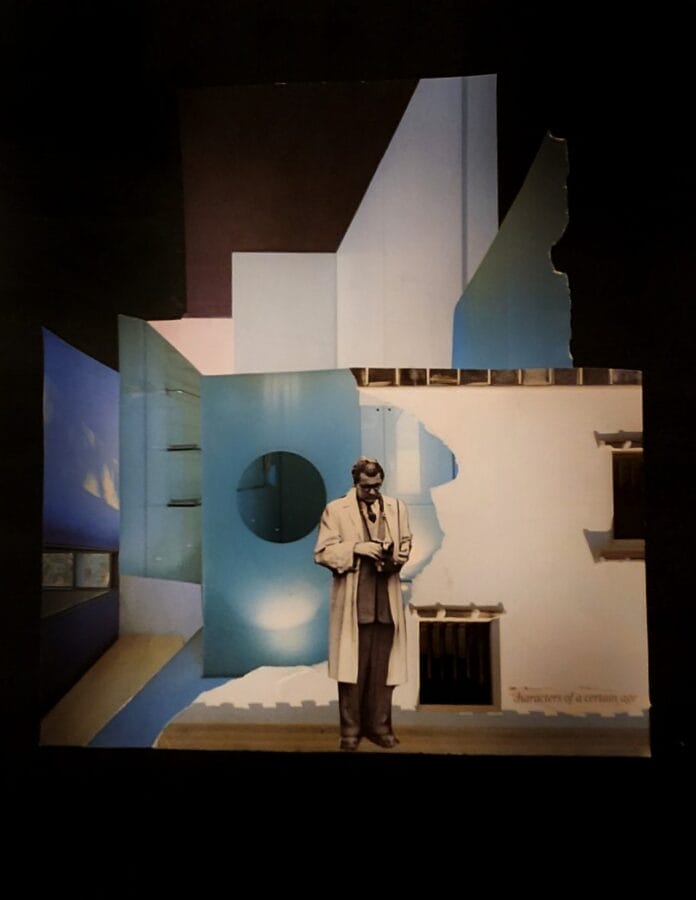Kenneth Ricci, known artistically as K.G. Ricci, creates works that bridge the worlds of literature, philosophy, and visual art. His collages are not simply arrangements of paper and images but carefully orchestrated meditations on existence, choice, and interpretation. Drawing upon the allegorical weight of Franz Kafka and the existential depth of Søren Kierkegaard, Ricci situates his art within a profound intellectual framework. Each piece becomes both a question and a resolution, an improvised act that finds its meaning in the very process of its construction.
Over the course of his career, Ricci has exhibited in 27 galleries, including numerous solo exhibitions, and his work has appeared in both national and international literary and poetry journals. His practice highlights the subtle yet powerful way collage can serve as a philosophical discourse, where images, fragments, and found elements enter into conversation with one another.
A Literary and Philosophical Framework
Ricci does not approach artmaking from a purely visual standpoint. Instead, his foundation is literary and philosophical. By invoking Kafka, he acknowledges the parable as a vehicle for ambiguity, paradox, and human struggle, an art form that resists definitive interpretation. Kierkegaard, by contrast, provides Ricci with a model of existential reflection, where aphorisms distill human complexity into piercing truths.
This dual influence sets Ricci apart. His collages operate much like textual fragments, where juxtaposed images take on the role of characters, symbols, or unresolved statements. They invite viewers to read rather than simply look, to interpret rather than passively consume.
The Improvised Process of Creation
For Ricci, the act of collage is both constrained and liberated by its materials. Unlike painting, where an artist can conjure form from a blank surface, collage is born from the availability of fragments, scraps of paper, textures, colors, and discarded images.
The process of creation is both constrained and liberated by the available elements at any given time, and it is the improvised procedure of choice, assembly, and judgment that settles the argument.
This improvisation underscores his practice. Each collage is a negotiation, an argument resolved through aesthetic decision-making. The artist becomes a mediator between chance and intention, between randomness and order. In this sense, Ricci’s work resonates with the philosophical idea that life itself is a series of constrained yet meaningful choices.
Collage as Philosophical Encounter
Collage has long been a medium of fragmentation and reassembly, echoing the fractured nature of modern life. Yet in Ricci’s hands, it becomes something more intimate: a dialogue with the human condition. His collages resist neat narratives, instead posing questions: What emerges when unrelated fragments meet? How does meaning shift when context is altered?
Just as Kafka’s parables often end in ambiguity and Kierkegaard’s aphorisms invite introspection, Ricci’s collages remain open-ended. They suggest that truth is not delivered whole but must be pieced together from fragments of experience, much like the scraps he arranges on paper.
A Career Rooted in Exhibitions and Publications
Ricci’s work has achieved recognition across diverse platforms. He has participated in 27 gallery exhibitions, including solo shows that allowed his philosophy-driven art to stand fully on its own terms. Beyond physical gallery spaces, Ricci has embraced the digital era, sharing his collages through online galleries that extend his reach to global audiences.
Equally significant is his presence in the literary world. His collages have been published in poetry and literary magazines, both online and in print, nationally and internationally. This placement is not incidental; it reflects the natural kinship between Ricci’s visual art and the written word. His work resonates with the fragmented intensity of poetry and the reflective cadence of prose, making it an ideal companion for literary publications.
The Relationship Between Image and Word
Ricci’s collages often behave like visual aphorisms. They are concise yet layered, dense yet suggestive. Just as an aphorism condenses wisdom into a single line, Ricci condenses philosophical reflection into an assemblage of fragments.
The result is not didactic but dialogical. Viewers are invited into a relationship with the work, urged to interpret, to draw connections, and to question their assumptions. In this sense, Ricci’s collages are visual texts, operating at the intersection of language, philosophy, and art. The Enduring Relevance of Ricci’s Work
In an age defined by information overload, fractured narratives, and competing truths, Ricci’s art feels especially relevant. His method acknowledges the fragmented nature of contemporary experience while also offering a way to make sense of it. Through choice, assembly, and judgment, his collages remind us that meaning is always constructed, never given.
By situating his practice within a literary and philosophical framework, Ricci challenges the boundaries of visual art. His collages become not only aesthetic objects but also philosophical encounters, asking viewers to reflect on the act of interpretation itself.
Conclusion
Kenneth Ricci’s art is not merely about the placement of fragments on paper but about the profound questions those fragments raise. His influences, Kafka’s parables and Kierkegaard’s aphorisms, reveal an artist deeply attuned to the ambiguities of existence and the necessity of interpretation.
Through decades of exhibitions, publications, and experimentation, Ricci has forged a body of work that blurs the boundaries between philosophy, literature, and visual art. His collages stand as reminders that meaning is not found but assembled, not fixed but continually reshaped by the interplay of chance and choice.
In Ricci’s universe, art becomes a form of thinking, and collage becomes a metaphysical dialogue, one that invites us to embrace the fragments of life as essential pieces of a larger, unfinished picture.


